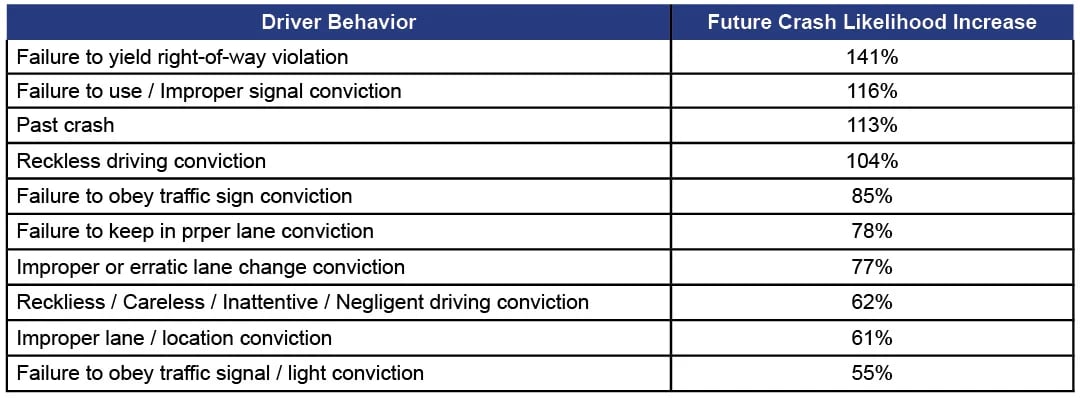Vehicle accidents represent one of the most significant loss exposures facing motor carriers. Even in a best-case scenario where no one involved was injured or killed, your driver was deemed not at fault, and the accident non-preventable, the incident still creates a significant business interruption, which can cost your company valuable time and money. On the flip side, what if the worst-case scenario occurs? The stakes can go way up, and the motor carrier could be looking at a severe claim in the event of a catastrophic loss.
The uncertainty surrounding these scenarios keeps trucking company owners and operations staff awake at night, but it does not have to be that way. The American Transportation Research Institute (ATRI) updated its “Predicting Truck Crash Involvement” study in 2022, and its findings show a strong link between unsafe driver behaviors and future crashes. The table below shows the top ten crash predictor behaviors, according to ATRI. As you consider these unsafe behaviors, ask yourself when you last evaluated your drivers. How many drivers have exhibited these unsafe behaviors?

PRE-EMPLOYMENT SCREENING PROGRAM
The Federal Motor Carrier Safety Administration’s (FMSCSA) Pre-Employment Screening Program (PSP) provides motor carriers, individual drivers, and industry service providers access to commercial drivers’ safety records from the FMCSA’s Motor Carrier Management Information System (MCMIS). PSP is a great tool to evaluate applicants before making a hiring decision. It provides an applicant driver’s most recent five years of crash data and the most recent three years of roadside inspection data. Records are available 24 hours a day.
DRUG AND ALCOHOL CLEARINGHOUSE
The FMCSA’s Commercial Driver’s License Drug and Alcohol Clearinghouse is a secure online database that gives employers and other authorized users real-time information about commercial driver’s license and commercial learner’s permit (CLP) holders’ drug and alcohol program violations. The Clearinghouse gives employers access to information they need to make informed safety decisions about which employees to place in safety-sensitive functions, including operating a commercial motor vehicle (CMV).
SAFETY MEASUREMENT SYSTEM
Every motor carrier’s safety data appears online in FMCSA’s Safety Measurement System (SMS). FMCSA updates the SMS monthly with data from roadside inspections, including driver and vehicle violations, crash reports from the last two years, and investigation results. The SMS data is organized into seven Behavior Analysis and Safety Improvement Categories (BASICs):
- Unsafe Driving – Speeding, reckless driving, improper lane change, inattention, no seatbelts, etc.
- Crash Indicator – Histories of crash involvement. (Not Public)
- Hours-of-Service (HOS) Compliance – Noncompliance with HOS regulations, including logbooks.
- Vehicle Maintenance - Brakes, lights, defects, failure to make required repairs, etc.
- Controlled Substances/Alcohol - Use/possession of controlled substances/alcohol, etc.
- Hazardous Materials Compliance - Leaking containers, improper packaging and placarding, etc.
- Driver Fitness - Invalid license, medically unfit to operate a CMV, etc.
SMS is free and an excellent tool for identifying good and bad trends and leading indicators that could lead to a future incident. For more information about SMS, go to https://csa.fmcsa.dot.gov.
TELEMATICS
Telematics systems collect data via sensors, GPS technology, and onboard diagnostics, allowing motor carriers to proactively track driver behavior and aggregate the data into driver scorecards. By providing each driver with a visual representation of their performance in critical areas, such as speeding, aggressive driving, and idling, managers can address problem behaviors and reward improvements. A scorecard can also serve as self-motivation for drivers when they see how they rank against other drivers in the fleet.
PERSONAL OBSERVATIONS
Conducting a personal interview and observing the driver during a road test are two methods of directly assessing a driver’s skills and habits. From evaluating the driver’s attention to detail while conducting a pre-trip vehicle inspection to observing how the driver operates a commercial motor vehicle in various conditions, personal observations can help a motor carrier determine if the driver not only meets the qualifications for the job but can also adhere to the company’s safety standards.
Note: These lists are not intended to be all-inclusive.
CALL TO ACTION
- Incorporate analytical tools into your applicant screening and selection processes.
Note: These lists are not intended to be all-inclusive.
This material is intended to be a broad overview of the subject matter and is provided for informational purposes only. Joe Morten & Son, Inc. does not provide legal advice to its insureds or other parties, nor does it advise insureds or other parties on employment-related issues, therefore the subject matter is not intended to serve as legal or employment advice for any issue(s) that may arise in the operations of its insureds or other parties. Legal advice should always be sought from legal counsel. Joe Morten & Son, Inc. shall have neither liability nor responsibility to any person or entity with respect to any loss, action, or inaction alleged to be caused directly or indirectly as a result of the information contained herein. Reprinted with permission from Great West Casualty Company.


